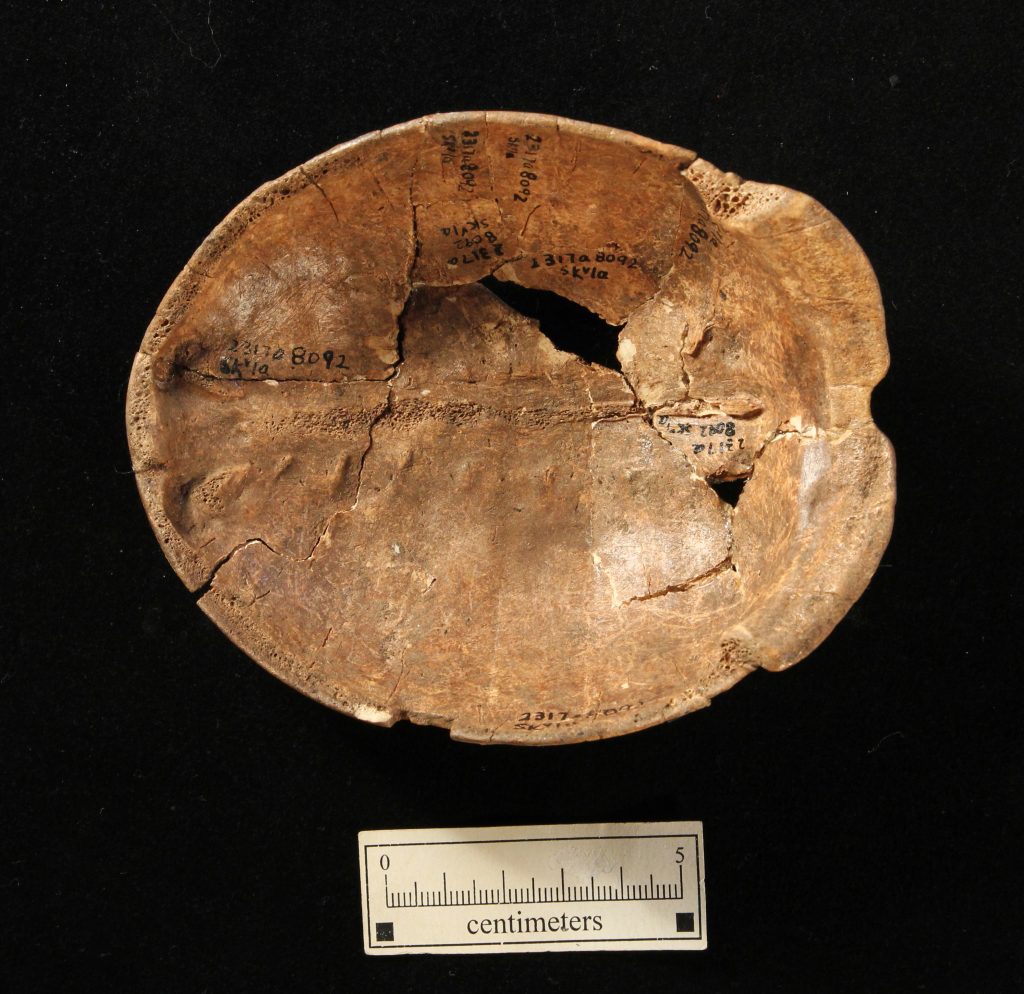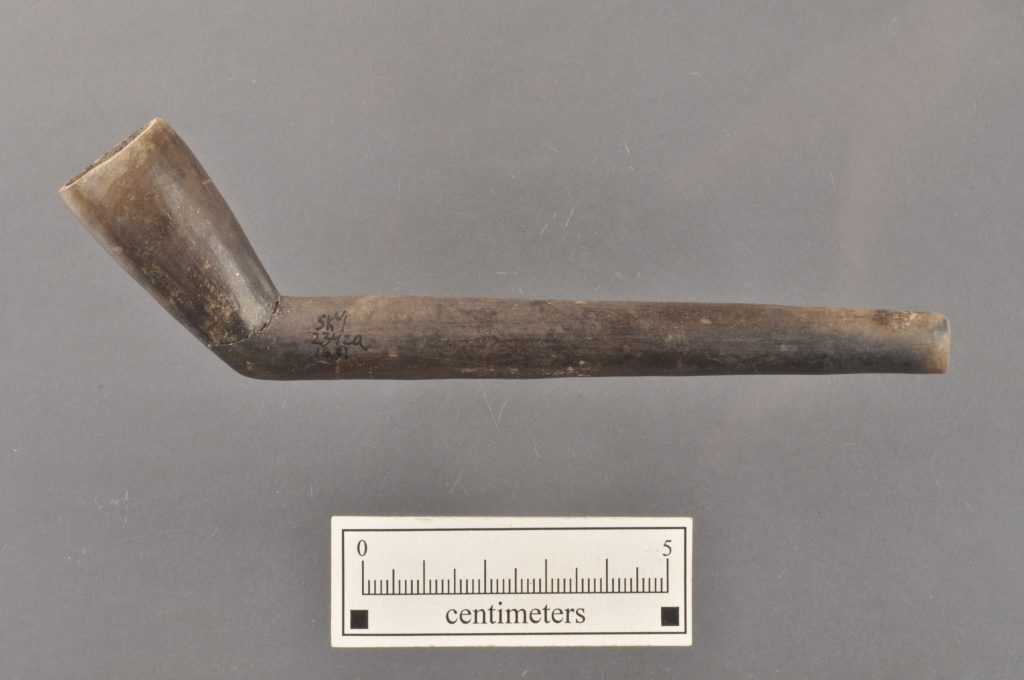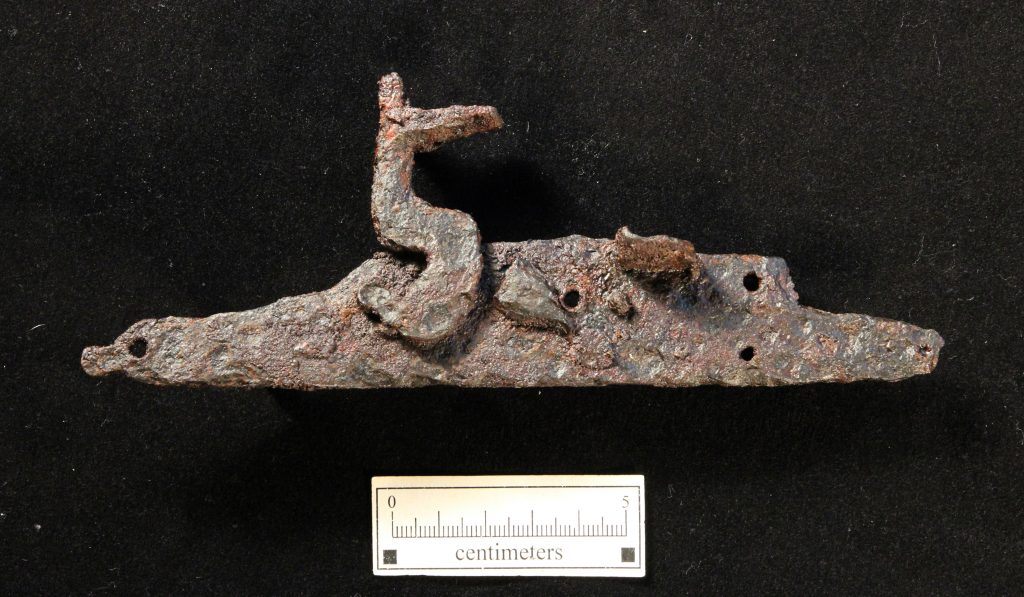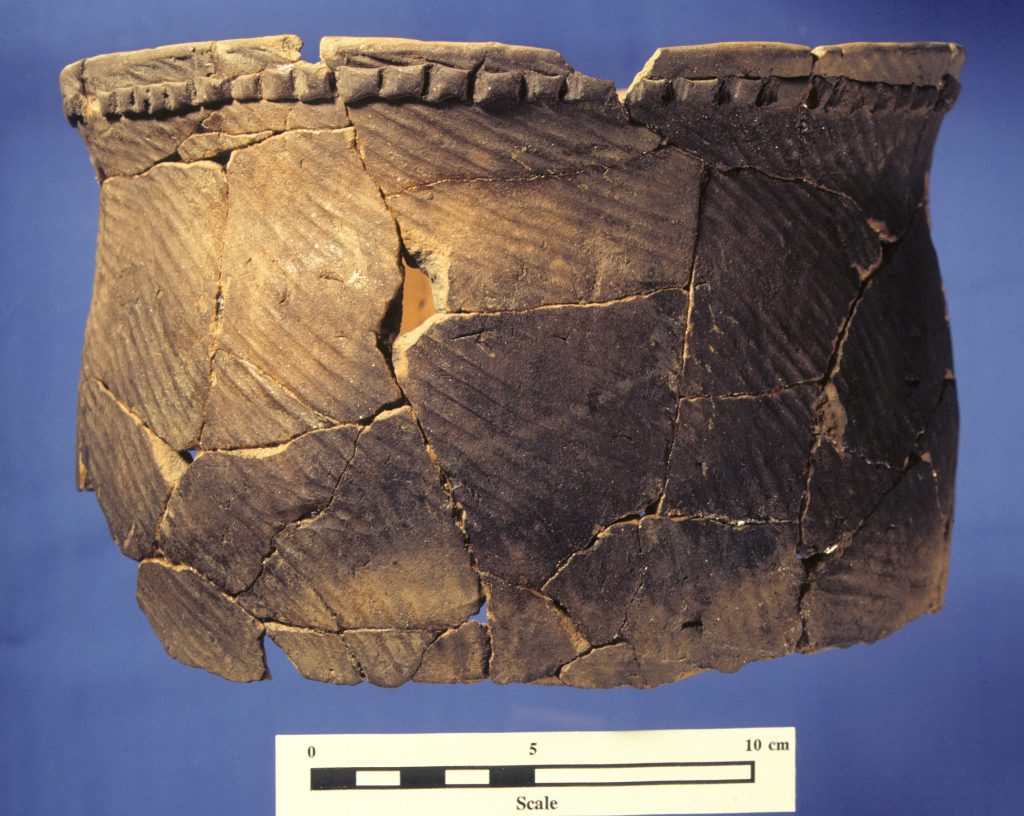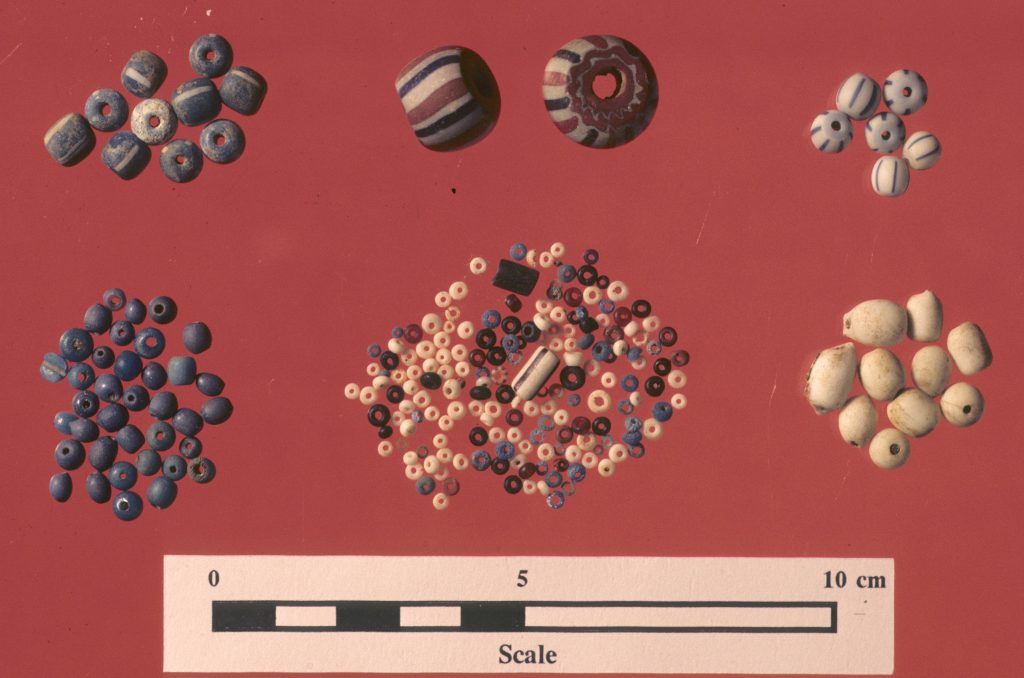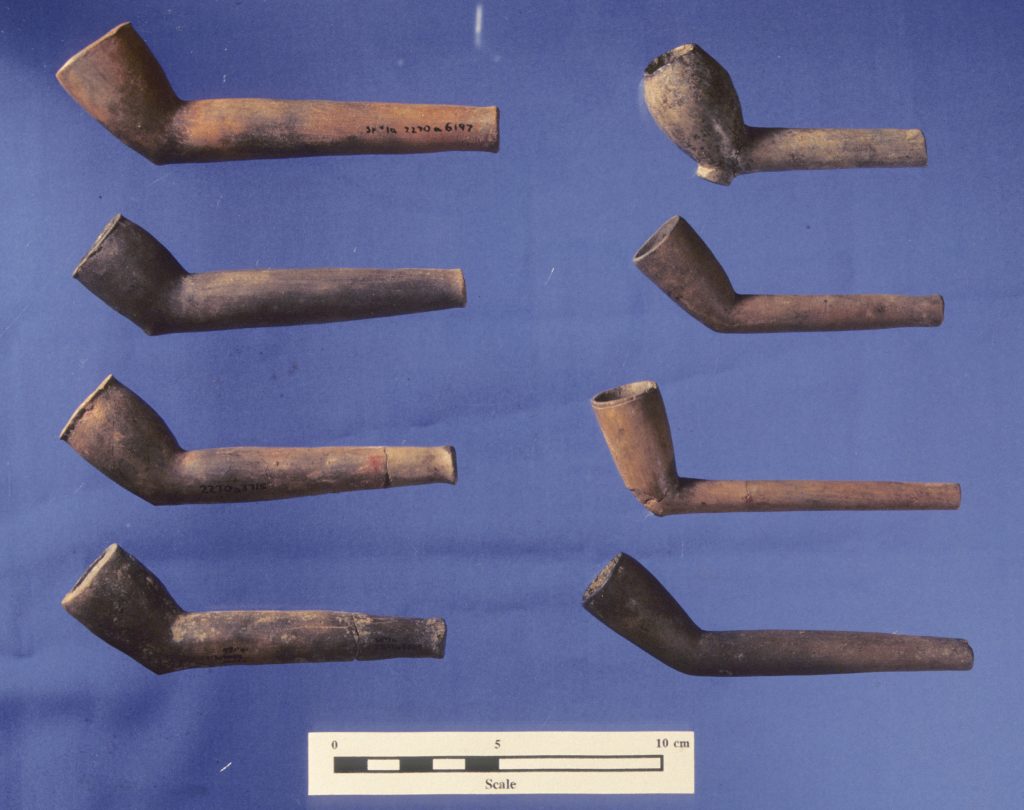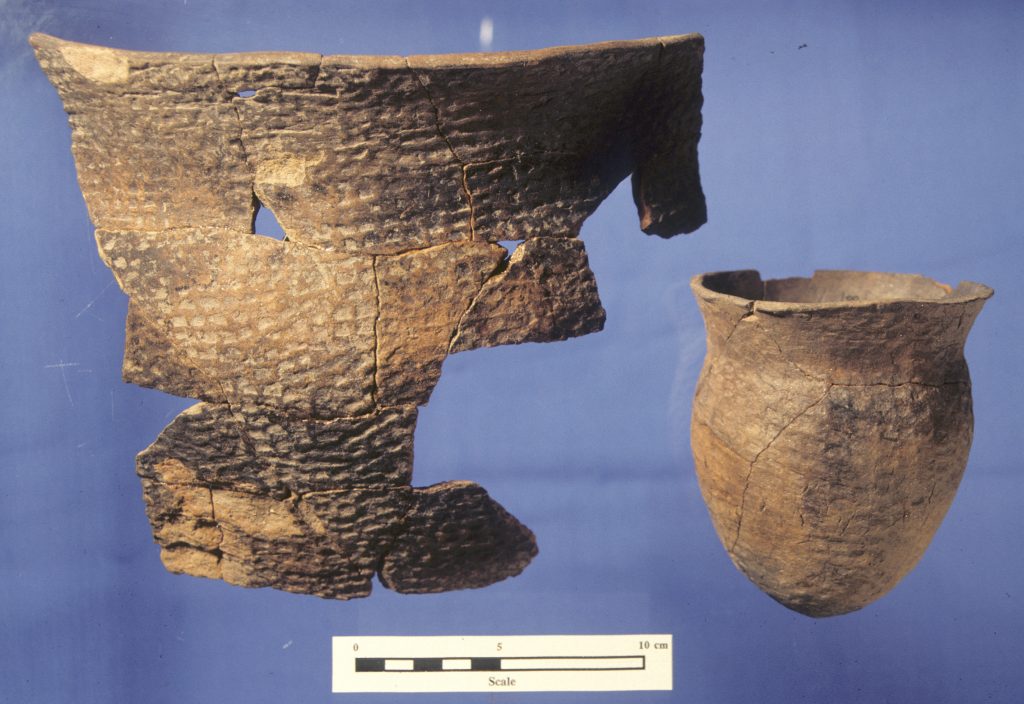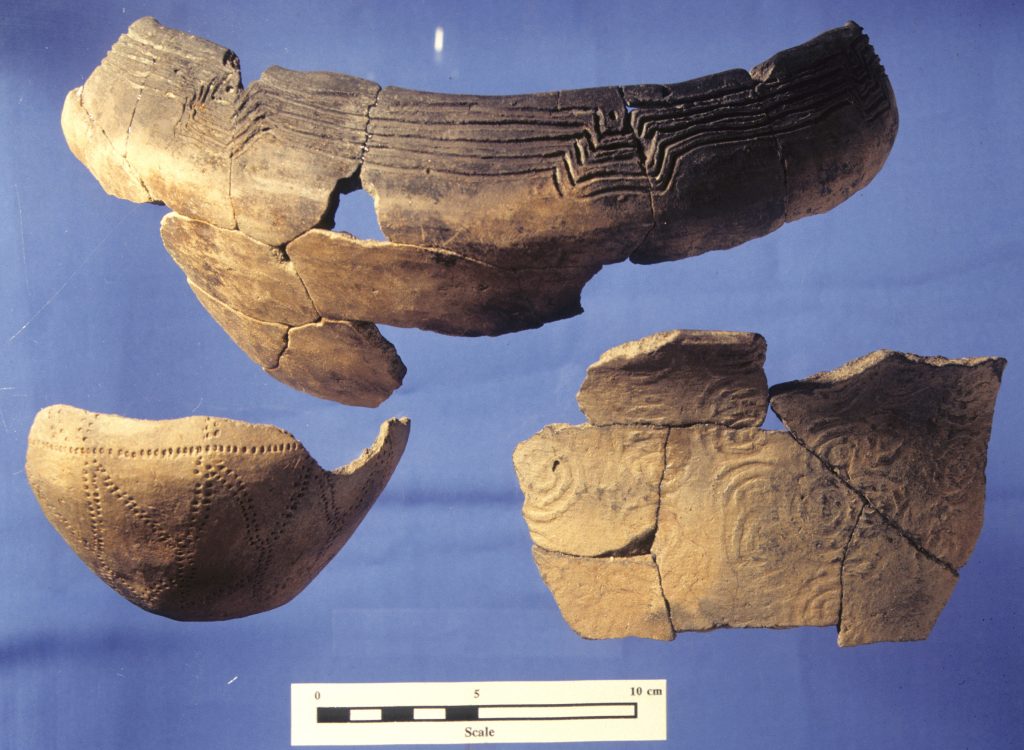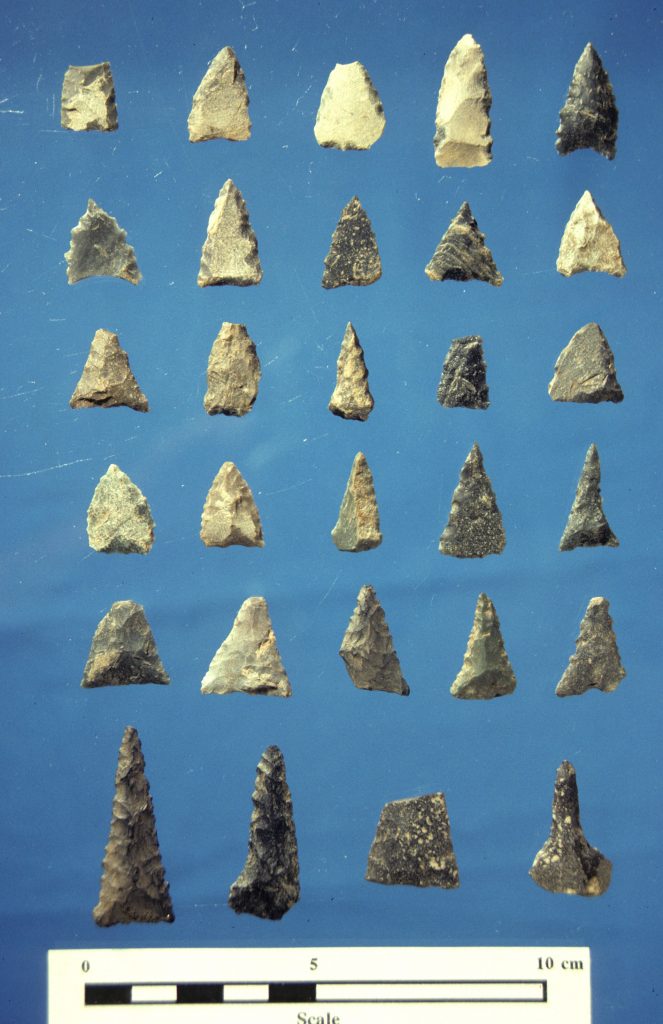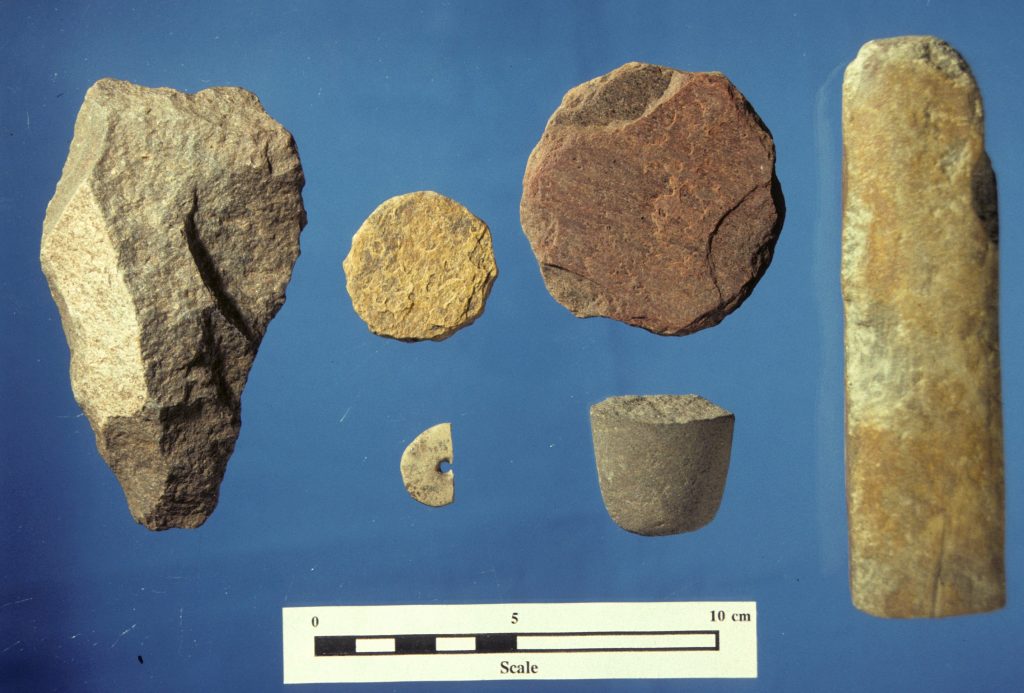North-Central Piedmont
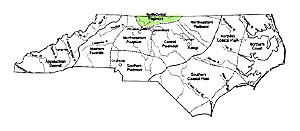 The North-Central Piedmont is that part of the North Carolina Piedmont drained by the Dan River, which then flows into Virginia. During the Paleoindian, Archaic, and Early and Middle Woodland periods, archaeology of the north central Piedmont is much like the rest of the Piedmont. After A.D. 1000 the local expression of the Piedmont Village Tradition is the Dan River phase.
The North-Central Piedmont is that part of the North Carolina Piedmont drained by the Dan River, which then flows into Virginia. During the Paleoindian, Archaic, and Early and Middle Woodland periods, archaeology of the north central Piedmont is much like the rest of the Piedmont. After A.D. 1000 the local expression of the Piedmont Village Tradition is the Dan River phase.
The Paleoindian is the time of the earliest generally accepted arrival of people in the southeastern United States – about 16000 years ago, or 14000 B.C. Although earlier migrations of people into the New World have been hypothesized, currently there is no firm evidence of people anywhere on the continental United States prior to 14000 B.C.
Our level of understanding of the Paleoindian period across the state is highly uneven, due to both the history of North Carolina archaeology and environmental and geological factors.
Paleoindian Chronology
Paleoindian in the Southeast is divided into Early, Middle, and Late subperiods.
Spear points of the Early Paleoindian period (14000 – 9000 B.C.) are large, fluted lanceolates, very similar to the classic Clovis points of the West. What we know about the earliest inhabitants of North Carolina is based almost entirely on surface finds of these points. Concentrations of Early Paleoindian points have been noted in the Tennessee, Cumberland, and Ohio River valleys, as well as western South Carolina, southern Virginia, and the northern Piedmont of North Carolina.
In the Middle Paleoindian period (9000 – 8500 B.C.) the number of spear points increases considerably and regional variability in spear point forms emerge. The Cumberland, Suwanee, and Simpson point types are thought to be typical of this subperiod. One thing all have in common is a narrowing or “waisting” at the base.
The Late Paleoindian period (8500 – 7900 B.C.) shows increased population growth. Dalton points are the diagnostic Late Paleoindian point type. By the end of the Paleoindian Holocene climatic conditions prevailed and the basic hunting and gathering lifeway that persisted for the next 5000 years was set.
Paleoindian Settlement and Subsistence
Paleoindian settlers in the Southeast found a rapidly changing landscape. Current evidence suggests that many of extinctions of Late Pleistocene megafauna – including the horse, mastodon, and mammoth – were complete by 8500 B.C.
East of the Mississippi River almost no Paleoindian tools have been found with these animals. Environmental differences between the Eastern and Western parts of the continent may have necessitated very different adaptations. By the middle Paleoindian period, if not earlier, the subsistence pattern was probably very similar to that of the Early Archaic period.
Most southeastern Paleoindian sites where more than a single point has been found are related to stone-quarrying activities. This pattern reflects a generalized foraging where groups rarely engaged in subsistence activities that produced recognizable traces in the archaeological record.
Paleoindian in the Piedmont
During the full glacial period (17000 – 14500 B.C.) before Paleoindians arrived, the Piedmont had been a boreal forest. As temperatures warmed conifers were replaced by deciduous forests (oak, hickory, walnut, elm, willow, and sugar maple) by 10500 BC. Continued warming brought new forests of sweet gum, chestnut, red maple, and tupelo gum by 7000 B.C. When Paleoindians first came into the Piedmont winters were harsher and summers cooler than today. For about 1000 years, both people and now-extinct Pleistocene animals co-existed in North Carolina.
Hardaway is the most recognizable site name in North Carolina. Most stone tools found in the Piedmont are made from a fine-grained rhyolite that outcrops in the Uwharrie Mountains. Excavations at the Hardaway site in Stanly County have yielded tons of rhyolite tools and chipping debris dating to the Late Paleoindian and Early Archaic periods. The site was first recognized as important in the 1930s and excavations began after World War II.
The oldest component at Hardaway was represented by Hardaway-Dalton points, Hardaway Side Notched, and Hardaway Blades, which date from 8500 to 7900 B.C. Other stone tools associated with the Hardaway complex, such as unifacial end scrapers and side scrapers, are very similar to those used by Paleoindians. In the Piedmont, roaming bands of hunter-gatherer Paleoindians probably enjoyed a wealth of natural resources that were exploited seasonally.
Close Paleoindian
The Archaic (8000 – 1000 B.C.) is an overarching time period covering over half of the time-span people have lived in North Carolina. This vast time has been explored by finding well-preserved deposits in rock-shelters and stratified, deeply-buried open sites in alluvial floodplains. The Archaic is generally thought of as a period dominated by nomadic, relatively small bands pursuing a hunting and gathering way of life, but there is evidence that some Archaic people settled into larger and more permanent sites relatively early.
From the coast to the mountains, the Archaic began with wandering bands of hunters and gatherers who faced a wide variety of changing environmental conditions. These bands occasionally came together at favored locations along major river valleys, but most of their time was spent in small groups scattered across the landscape foraging for food and raw materials.
Toward the end of the Archaic, large groups began to settle down and live most, if not all year in areas rich in raw material and food resources. This settled life spawned the beginnings of plant domestication and use of pottery, hallmarks of the succeeding Woodland.
The Archaic in the Piedmont
As in the preceding Paleoindian span, much more is known about the Archaic in the Piedmont than either the mountains or the coastal areas. From the 1930s through the 1960s North Carolina sites in the Piedmont were especially important in Archaic research of the eastern United States.
In many parts of the country Archaic research focused on rock shelters, where dry alkaline conditions helped preserve organic remains. But in North Carolina, archaeologists were able to define long chronological sequences by excavating deeply buried, stratified sites in the alluvial floodplains of the Piedmont. In early excavations at buried floodplain sites such as Doerschuk and Lowder’s Ferry along the Yadin-Pee Dee River, and at the nearby Hardaway site, the cultural sequence was established that still defines the Archaic in North Carolina and throughout much of the eastern United States.
The Early Archaic (8000 – 6000 B.C.)
The Early Archaic is generally viewed as the period when native populations began to adapt to an environment created by Holocene climatic conditions – conditions very similar to those of today. The Early Archaic in the Piedmont has been divided into two parts, the Palmer phase (8000 – 7000 B.C.) and the Kirk phase (7000 – 6000 B.C.).
Available subsistence information suggests that Early Archaic plant food collection focused on hickory nuts and acorns. Archaeologists presume that white-tailed deer provided the main source of meat. A dramatic increase in Early Archaic sites across the state suggests an increase in the overall population. Although subsistence strategies on the Piedmont changed little from those of the Late Paleoindian period, Early Archaic tool kits did change. New ways of attaching spears resulted in marked changes in the way points were made.
During the Palmer phase (8000 – 7000 B.C.) small, well-made end scrapers characteristic of the Late Paleoindian period continued to be made. During the Kirk phase (7000 – 6000 B.C.) scrapers were cruder and varied greatly in size and form. Adzes, gravers, drills, and perforators were made for working wood, hides, and animal bones into tools and ornaments. Cobbles were used as hammers and anvils to fashion other tools or crush and grind plant and animal resources. Groundstone tools are rare during the Early Archaic.
Early Archaic inhabitants were organized into small mobile bands (probably numbering 50 – 150 individuals). The North Carolina Piedmont offered a cornucopia of plant and animal foods, so the distribution of food resources may not have determined band territories. Some researchers believe Early Archaic bands ranged over entire drainage systems, while others believe that band territories were related to important stone resources and thus overlapped drainages.
Middle Archaic (6000 – 3000 B.C.)
During the Middle Archaic small kin-based groups moved from place to place pursuing a foraging subsistence strategy. The Middle Archaic in the Piedmont has been divided into three phases of about 1000 years each: Stanly, Morrow Mountain, and Guilford.
Simple but ubiquitous Middle Archaic tool assemblages suggest that new settlement and subsistence patterns (small, kin-related groups moving as units from place to place) formed as a response to climatic changes. This foraging pattern allowed groups to move more easily among the patchy, less predictable resources created under the warmer and drier conditions of the Middle Archaic.
Divisions of the Middle Archaic in the Piedmont are based on distinctive styles of spear points originally identified at Lowder’s Ferry and Doerschuk, sites in Stanly and Montgomery counties respectively. Deeply buried archaeological deposits at these sites, and at the Gaston site in Halifax County, show cultural continuities through the Middle Archaic.
Evidence for use of the atlatl, or spear-thrower, is first seen during the Stanly phase. Crude chipped-stone axes with lateral hafting notches have been recovered with Guilford points at the Gaston site. Other than these two innovations, there does not appear to be much that stands out about Middle Archaic tool assemblages.
Middle Archaic sites are numerous and appear to represent mostly temporary encampments. They occur across the Piedmont landscape without any obvious preference for particular environmental niches.
Late Archaic (3000 – 1000 B.C.)
In the Late Archaic, climatic conditions improved and there was a gradual trend towards more sedentary life. In the North Carolina Piedmont, it is difficult to walk over any plowed field with a nearby source of water and not find evidence of a Late Archaic campsite.
Although Late Archaic sites are numerous in the Piedmont, the full spectrum of Late Archaic culture is not found here. Large shell middens with cooking hearths, sand floors, and human and dog burials are found along the Atlantic coast. These vigorous, socially complex, semipermanent settlements are unlike any before. Similar sites are found along the broad shoals of the Savannah, Tennessee, and Green Rivers in Georgia, Alabama, Tennessee, and Kentucky. It is at sites like these that pottery first appeared and native plants were gradually domesticated.
During the Late Archaic period, people living along the south Atlantic coast from Florida to North Carolina had begun to make fiber-tempered pottery. Stalling series pottery, made by molding lumps of clay and fibrous material into simple vessel forms, was made as early as 2500 B.C. By the beginning of the Woodland in North Carolina, several different ceramic traditions had been established across the state.
The most characteristic artifact of the Late Archaic period is a large, broad-bladed point with a square stem, called Savannah River Stemmed. Savannah River points indicate the Late Archaic period from New York to Florida. Late Archaic peoples also used hammerstones to peck and grind hard rocks into axes with grooves for hafting. They also made a variety of scrapers, drills, and other chipped-stone tools, as well as polished stone weights for atlatls.
During the latter half of the Late Archaic period, hemispherical bowls were pecked and carved from soapstone. Along the coasts of Florida and South Carolina, the first pottery vessels were invented at the end of the Late Archaic period.
Seeds and nuts were ground with stone mortars, and the use of fish nets is attested by notched stone pebbles that served as netsinkers. Squash and gourds were cultivated as early as the third millennium B.C. and, by the end of the Late Archaic period, sunflower, maygrass, and chenopodium were harvested as a precursor to active cultivation.
Close Archaic
Three interrelated innovations marked the end of the Archaic and the beginning of the Woodland: pottery-making, semi-sedentary villages, and horticulture. All had their origins in the Archaic but became the norm during Woodland times.
The widespread appearance of pottery-making is viewed as going hand in hand with an increasing reliance on seed crops and more permanent settlement. Domestication of early cultigens laid the groundwork for later acceptance of tropical cultigens. Corn was not widely grown until after A.D. 700 and did not become an important food crop in many areas until after A.D. 1000. With the introduction of beans around A.D. 1200, the eastern agricultural triad of corn, beans, and squash was completed.
In North Carolina, the Woodland is divided into Early, Middle, and Late periods. Along the coast and through much of the Piedmont, the Late Woodland continues until Contact, while in the Appalachian Summit, Western Foothills, and the Southern Piedmont, Mississippian and Mississippian-influenced societies developed after A.D. 1000.
The Woodland cultures of the North Carolina Piedmont were only marginally influenced by cultural traditions elsewhere in the eastern United States. The rich and elaborate Hopewell and Swift Creek cultures that influenced wide areas of the Southeast had little impact on cultural developments in the Piedmont. And the powerful Mississippian chiefdoms that later dominate most of the Southeast were only able to penetrate the southern fringe of the Piedmont.
Piedmont Tradition Early and Middle Woodland Periods (1000 B.C. – A.D. 800)
Although we know relatively little about their origins during the Early Woodland period, cultures throughout most of the Piedmont steadily evolved along an unbroken continuum from about A.D. 1000 until the time of first contacts with Europeans. Subsistence seems to have remained evenly balanced between crop production and wild plant and animal resources. Social distinctions were based primarily on age and sex. Egalitarian Woodland societies were woven together by kinship and leadership roles were achieved rather than ascribed.
Only in the southern Piedmont is the Piedmont Village Tradition broken by the spread of the South Appalachian Mississippian tradition into the Yadkin-Pee Dee River Valley.
The stratigraphic and stylistic relationships among various ceramic types during the first half of the Woodland period are still unclear. Badin, Yadkin, Vincent, and Clements series ceramics are guides to occupations of the Piedmont during this time.
Aquatic resources are important during this time and a wide variety of mammals and birds were eaten. Several species of weedy plants, including maygrass, knotweed, goosefoot, and sunflower, although no direct evidence of these practices have yet been found in the Piedmont.
During this time the bow and arrow completely replaces the atlatl.
Badin Phase (ca. 500 B.C. ?)
The Badin phase is named for the small Stanly County town. Near Badin, at the Doerschuk site, the Badin ceramic series was found in a soil zone overlying the Late Archaic Savannah River level.
At the Doerschuk site in Stanly County, the Badin ceramic series was found in a soil zone overlying the Late Archaic Savannah River level. Badin vessels, well-made and tempered with sand, were simple in form, consisting of straight-sided jars with conical bottoms. Vessels were stamped with cord-wrapped and fabric-wrapped paddles. Badin ceramics appear to be related to the Early Woodland Deep Creek wares of North Carolina’s coastal region.
In addition to the abrupt introduction of ceramics, an entirely different form of projectile point was thought to be associated with the Badin Phase. Crudely flaked, triangular “Badin” points represent quite a departure from the large, stemmed spear points of the Savannah River phase.
Based primarily on radiocarbon dates for the succeeding Yadkin phase, archaeologists think that the Badin phase must date to around 500 B.C. One thing that is surprising in the North Carolina Piedmont is the small number of Badin and Yadkin phase sites compared to the relatively large number of Late Archaic Savannah River phase sites.
Otherwise, we know very little about aboriginal life styles during the Badin Phase. Probably very little changed from the Late Archaic period except for the gradual incorporation of the bow and arrow and ceramic containers. Technology was still primarily adapted to a hunting-and-gathering way of life.
Yadkin Phase (ca. 300 B.C. – ca. A.D. 800?)
The Yadkin ceramic series, which is thought to follow after Badin ceramics, was also defined at Doerschuk site. Yadkin is similar to Badin except for being tempered with crushed quartz. Cord-wrapped and fabric-wrapped surfaces persist, but new kinds of surface treatments – check stamping, linear check stamping, and simple stamping made with carved wooden paddles – are added. These treatments tie Yadkin phase pottery to the Early Woodland Deptford wares common in Georgia in South Carolina. Yadkin projectile points are typically large triangular forms that resemble Badin points but are more finely flaked.
Radiocarbon dates for Yadkin and Yadkin-like ceramics generally fall between 290 B.C. and A.D. 60, so it is unclear whether Badin ceramics predate Yakin in all areas of the Piedmont. Some Yadkin sites may have been occupied for relatively long periods of time and lasted until the latter part of the phase, around A.D. 500.
Yadkin phase sites occur more frequently than Badin phase sites, especially in the southern Piedmont and the South Carolina Coastal Plain. Still, evidence relating to the way Yadkin people lived are rare. As Early Woodland research continues across the Piedmont, we will probably see more and more variability in the early ceramic traditions and find that what holds true for one region may not hold true for another.
Piedmont Tradition Late Woodland Period (A.D. 800 – 1600)
The Late Woodland across the Piedmont begins with the Uwharrie phase. After A.D. 1100, major cultural changes took place as regional manifestations of the Piedmont Village Tradition emerged. The local expression of the Piedmont Village Tradition in the northwestern Piedmont is the Donnaha phase.
Cultures throughout most of the Piedmont steadily evolved along an unbroken continuum from about A.D. 1000 until the time of first contacts with Europeans. Subsistence seems to have remained evenly balanced between crop production and wild plant and animal resources. Social distinctions were based primarily on age and sex. Egalitarian Woodland societies were woven together by kinship and leadership roles were achieved rather than ascribed.
Even though there were no sharp breaks or glaring innovations with the beginning of the Late Woodland period in Piedmont North Carolina, major cultural changes took place between A.D. 1100 and 1600 as regional manifestations of the Piedmont Village Tradition emerged. This was a time of population consolidation and the beginning of intertribal conflicts. In much, but not all, of the Piedmont, larger villages surrounded by stockades protected inhabitants. This was probably the result of increased agricultural production and efficiency, and competition for good agricultural lands.
Establishing linkages between archaeological complexes and specific tribal groups is often difficult and sometimes impossible. There is, however, a marked increase in the diversity of the archaeological record throughout the Piedmont during the latter half of the Late Woodland period. Much of that diversity no doubt coincides with ethnic and tribal differences taking shape at this time. The Dan River and Saratown phases probably represent people ancestral to the Sara Indians. Along the Eno River, Hillsboro phase may be related to the Eno, Shakori, and Occaneechi tribes. Further south, in the Haw River, the Haw River, Hillsboro, and Mitchum phases are possibly linked to the Sissipahaw Indians. The Gaston phase may represent the Occaneechis, Tutelos, and Saponis.
The southern Piedmont saw the arrival of the Pee Dee culture – mound builders with a highly stratified and politically complex society. Pee Dee culture shares more traits with the Pisgah phase of Appalachian Summit than the Siouan cultures of the Piedmont. Both were part of the South Appalachian Mississippian cultural tradition.
Uwharrie Phase (A.D. 800-1200)
The Uwharrie phase, with sites throughout central North Carolina, is the “mother” of all succeeding phases of the Piedmont Village Tradition. Although named for the southern Piedmont, Uwharrie phase sites are distributed throughout central North Carolina. Uwharrie phase is the “mother” of all succeeding phases of the Piedmont Village Tradition.
The relatively small Uwharrie villages are more sedentary than during the preceding Woodland periods. Increased reliance on domesticated plant foods is reflected in the archaeobotanical record, the large subterranean storage facilities, and the phase’s typical large conical jars.
Hunting, gathering, and fishing were still the mainstays of Uwharrie subsistence, but garden crops, including corn, became important, particularly towards the end of the Uwharrie phase.
Uwharrie pottery continued in the same basic tradition as the Badin, Yadkin, Vincent, and Clements styles, although vessel surfaces were finished with a coarse, net-like material and Uwharrie potters began to decorate their pots with crudely incised parallel lines.
Burials, placed in simple oval pits, were sometimes adorned with shell beads and other ornaments, and placed in cemetery-like areas away from the main habitation area.
From this widespread pattern of Uwharrie adaptation emerged the riverine-focused, nucleated settlements that characterized the last half of the Piedmont Village Tradition.
Dan River Phase (A.D. 1000-1450)
The Dan River phase emerged in the upper Dan River drainage of the northern Piedmont at the same time as the Haw River phase of the central Piedmont. A much larger population occupied the Dan River Valley during Late Woodland Times than the Eno and Haw River drainages. After the 13th century Dan River phase people aggregated into substantial large villages.
Early Dan River sites were very similar to those of the Haw River phase, with linear communities of houses and associated features strung out parallel to the river bank.
Large storage pits contained a wide variety of plant and animal remains, while evidence of maize was recovered from almost every pit feature. Beans, sunflower seeds and maize clearly indicate the importance of agriculture after A.D. 1000.
During the first half of the Dan River phase, Uwharrie influences are clearly evident. Most pots were formed into large storage and cooking vessels. Decorations consisted of notches along the lip, incised or brushed lines around the neck, or sometimes fingernail pinches or punctations in the neck area.
Most Dan River phase pottery is net-impressed. Large storage and cooking jars with constricted necks and flaring rims continued to be made along with smaller bowls. Vessel decoration increased in popularity from early to late Dan River sites. Finger pinches, stick incisions, and reed punctations were applied in bands around the shoulder area, while lips were commonly notched, incised, or punctated with reeds.
One of the most striking features of the Dan River phase is the variety of ornaments and tools made from bone, shell, and clay. Awls, pins, needles, fishhooks, beamers, gouges, antler flakers, antler picks, and turtle carapace bowls and cups, as well as a variety of beads, represent some of the bone artifacts. The edges of mussel shells were serrated and used as scrapers. Marine whelk shell was carved and ground into long and short beads, gorgets, and pendants. Marginella and olive shells were used to make beads. Clay was fashioned into cups, spoons, dippers, beads, and a variety of smoking pipes.
During the last half of the Dan River phase, settlement size and density increased dramatically. Many of these larger and more numerous settlements were located along the banks of the Smith and Mayo rivers in southern Virginia, as well as along the Dan River in North Carolina. Circular, stockaded villages from one to two acres in extent contained fifteen to twenty households with associated storage pits, hearths, and burials. These encircled open central plazas. Late Dan River phase villages were located on wide alluvial terraces of the Dan River and its major tributaries.
It seems likely that the rise of large fortified communities may be related to an increase of Iroquois raids from the north into the Eastern Siouan heartland.
Early Saratown Phase (A.D. 1450-1600)
Early Saratown sites in the North-Central Piedmont follow the Dan River phase and date to the period just before contacts with Europeans. These sites show signs of a stable population joined in fewer but larger villages. The phase was defined from excavations at the Hairston site (aka Early Upper Saratown), one of the most intensively occupied sites in the Dan River valley.
Early Saratown phase pottery has been described as the Oldtown series – a well-made ware with fine paste and smooth interiors. The majority of sherds have smooth or burnished surfaces, while others have net-impressed surfaces. Decorations include rim notching, finger pinching, and stick punctation similar to Dan River phase ceramics. New decorative techniques include rim castellations, lip burnishing, and the application of filleted strips. Vessel forms include bowls and jars. Influences from the Catwaba drainage to the south are present.
Burials at Hairston contained a rich array of grave goods, in stark contrast to the earlier Haw River and Dan River phases. Shaft-and-chamber burials were accompanied by the most offerings, including hundreds of bone and shell beads, bone awls, shell hair pins, serrated mussel shells, three “rattlesnake” or “Citico”-style gorgets, and a single pottery vessel. Contact with a copper bar gorget preserved a piece of pine bark covering one burial.
The majority of features at Hairston were large cylindrical or bell-shaped storage pits. Earth ovens, shallow basins, and hearths were also found.
Compared with the earlier Dan River phase remains, the Early Saratown phase had a much broader-based subsistence. A wide range of resources from a variety of habitats sustained Early Saratown people. The size and intensity of the Hairston site occupation suggest that the increased reliance on agriculture that began during the preceding Dan River phase reached its peak just before contact with the first Europeans.
The occupations of the Sara Indians in this area continued until after A.D. 1700 as the Middle Saratown and Late Saratown phases.
Close Woodland
The time of contact between Indians living in North Carolina and Europeans arriving from Spain and England varied considerably across the state. The expedition of Hernando de Soto passed through western North Carolina in the spring of 1540. Pardo’s expeditions into the same areas came less than 30 years later. The first English attempts at settlement in northeastern North Carolina came about 20 years after that, starting in 1584. But it was not until after about 1650, when English explorers, traders, and settlers came from Tidewater Virginia, that North Carolina’s Indians felt the brunt of the European presence on their land.
Accordingly, the beginnings of these arrivals do not necessarily herald the beginnings of significant changes in the histories of North Carolina’s tribes. Overall, however, this was a time of sweeping and often devastating change.
Contact in the North-Central Piedmont
Starting in 1983, the University of North Carolina’s second Siouan Project succeeded in finding sites of the Siouan tribes who interacted with the European explorers, traders, and settlers who moved into the North Carolina backcountry during the last half of the seventeenth century and early eighteenth century.
In the North-Central Piedmont two Contact-era phases of the Sara (or Saura) tribe follow the Early Saratown phase and provide a chronology of changes.
Middle Saratown Phase (A.D. 1620-1670)
The Middle Saratown phase represents the mid-17th-century occupation of the upper Dan River drainage by the Sara Indians. This phase was defined by excavations at the Lower Saratown site located along the Dan River. The site marks the arrival of European trade goods in the North-Central Piedmont, but little else seems to change.
Prior to 1670 the Sara were well-insulated from the Europeans. It is doubtful that many of the Sara during the Middle Saratown phase ever laid eyes on the English or felt the deadly sting of their diseases. The beads and trinkets that found their way to the Sara villages were passed along from Indian to Indian through traditional trade networks.
Settlement patterns during the Middle Saratown changed little from the preceding Early Saratown phase. The Sara continued to occupy large stockaded villages and populations were stable. No European influences are seen in settlement, subsistence, and technology. All this changed in the subsequent Late Saratown phase.
Late Saratown Phase (A.D. 1670-1710)
The Upper Saratown village, located along Dan River near its confluence with Town Fork Creek is the most extensively excavated Late Saratown village.
At the end of the Middle Saratown phase, about A.D. 1670, the flow of English-made goods reaching the Sara increased dramatically. Sometime after this European diseases struck with devastating force, making many of the excavated villages look more like cemeteries than habitation sites.
Community patterns changed drastically during the Late Saratown phase. The Upper Saratown site, occupied during the first half of the phase, consisted of a stockaded village occupied by between 200 and 250 persons living in circular houses. A very different pattern is seen by the close of the 17th-century, when the Sara communities are made up of widely dispersed households. Ceramic evidence suggests that fragments of ethnically diverse tribes may have merged with the Sara in these late sites to form a dispersed refugee community.
Pottery from the Late Saratown sites is called the Oldtown series. Smoothed and burnished surfaces are most common, followed by net-impressing. Most of the pots are large cooking or storage jars. Hemispherical and cazuela bowls were also found, often decorated with incised lines and punctations.
The basic subsistence pattern of the previous two centuries continued in the Late Saratown phase, with a balance between wild and native domestic food sources. Like other Piedmont Siouan phases, there is no evidence that European animals played a role in the subsistence cycle.
Mortuary patterns reflect dramatic changes during the Late Saratown phase. Large amounts of European-made ornaments, particularly glass beads and copper trinkets, accompanied burials, which were placed in the village within and near houses. At first, burials matched earlier forms, but toward the end of the phase a drastic change took place. Cemeteries with numerous shallow burial pits and very few associated artifacts were created away from villages, perhaps indicating awareness of the contagiousness of European diseases. The fact that most of the dead were subadults may indicate their deaths resulted from a single epidemic.
Despite the drastic population loss that occurred after Contact, North Carolina today is the home of the largest Native American population east of the Mississippi River. The robust cultural diversity seen in the archaeological record of the last 12,000 years survives today in the tribal traditions of North Carolina’s native peoples.
Close Historic
- Bone beamer from the Upper Saratown site in Stokes Co., NC
- Turtle shell bowl from the Upper Saratown site in Stokes Co., NC
- Clay pipe from the Hairston site in Stokes Co., NC
- Musket sideplate and hammer from the Upper Saratown site in Stokes Co., NC
- Oldtown Simple Stamped jar from the Hairston site in Stokes Co., NC
- Metal trade artifacts from the Upper Saratown site in Stokes Co., NC
- Glass beads from the Upper Saratown site in Stokes Co., NC
- Clay pipes from the Upper Saratown site in Stokes Co., NC
- Oldtown Check Stamped jars from the William Kluttz site in Stokes Co., NC
- Oldtown Plain bowls and Complicated Stamped jar from the William Kluttz site in Stokes Co., NC
- Chipped-stone arrow points and drills from the William Kluttz site in Stokes Co., NC
- Stone celts, hoe, disks, and bead from the William Kluttz site in Stokes Co., NC
« Previous 1 2 3 4 5 Next »
Artifacts, 3D models, and videos to come


